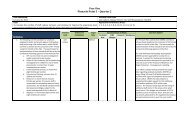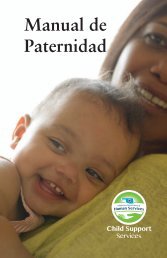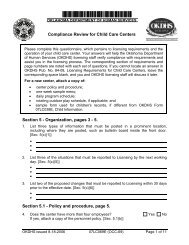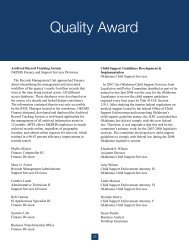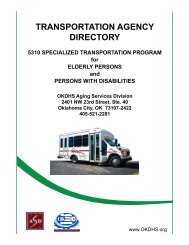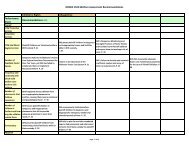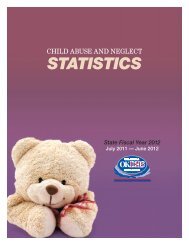The Oklahoma Pinnacle Plan - Oklahoma Department of Human ...
The Oklahoma Pinnacle Plan - Oklahoma Department of Human ...
The Oklahoma Pinnacle Plan - Oklahoma Department of Human ...
You also want an ePaper? Increase the reach of your titles
YUMPU automatically turns print PDFs into web optimized ePapers that Google loves.
<strong>The</strong> <strong>Oklahoma</strong> <strong>Pinnacle</strong> <strong>Plan</strong>:<br />
An Improvement <strong>Plan</strong> for Child Welfare Services<br />
March 2012<br />
INITIATIVES FOR PINNACLE POINT 4:<br />
Year One (SFY 2013)<br />
1. By December 31, 2012, OKDHS will finalize the practice model evaluation plan and<br />
develop a timeline for fidelity reviews for each component <strong>of</strong> the practice model. <strong>The</strong><br />
initial focus will include the Assessment <strong>of</strong> Child Safety, Safety <strong>Plan</strong>ning, and Family-<br />
Centered Services (FCS). This work is critical to ensuring interventions are appropriate<br />
and children are safely maintained in their own homes whenever possible.<br />
2. By December 31, 2012, OKDHS will complete a data analysis <strong>of</strong> permanency outcomes<br />
for children statewide in order to better understand trends, issues, and possible service<br />
gaps related to reunification. Within 90 days, OKDHS will create strategies to improve<br />
reunification in those counties experiencing lower reunification rates than the state<br />
average.<br />
3. By December 31, 2012, OKDHS will identify the targeted group and number <strong>of</strong> children<br />
to be served in the Permanency Roundtables process during Year Two.<br />
4. By April 1, 2013, OKDHS will complete the fidelity review regarding Assessment <strong>of</strong><br />
Child Safety, Safety <strong>Plan</strong>ning, and FCS. This will result in specific recommendations for<br />
improvements to be implemented in Year Two (SFY 2014).<br />
Year Two (SFY 2014)<br />
5. By July 1, 2013, OKDHS will identify the critical components <strong>of</strong> the practice model and<br />
clarify each position’s role in implementation; the role <strong>of</strong> each position will be<br />
incorporated into the annual evaluation. This encompasses the skills and tasks<br />
associated with the practice model that link directly to individuals’ overall evaluation<br />
and training plan.<br />
6. By July 1, 2013, OKDHS will conduct a data analysis <strong>of</strong> adoption cases in order to<br />
understand trends and issues related to timeliness <strong>of</strong> adoption after termination <strong>of</strong><br />
parental rights (TPR). Within three months, OKDHS will create and implement<br />
strategies to shorten the length <strong>of</strong> time to adoption finalization for those counties<br />
experiencing a greater length <strong>of</strong> time than the state average.<br />
7. OKDHS will support a pilot project for a parenting curriculum and support model for<br />
adoptive families, both trial and finalized adoptions. This will be modeled after an<br />
evidenced-based program and will be supported through an existing relationship with<br />
Center for Child Abuse and Neglect (CCAN). This is also described in <strong>Pinnacle</strong> Point 1 –<br />
Initiative 14d, but it is specific to foster parents in that section.<br />
8. By December 31, 2013, OKDHS will incorporate the use <strong>of</strong> research-based tools to<br />
evaluate the engagement and collaboration <strong>of</strong> a random sample <strong>of</strong> families, which is<br />
critical in the practice model.<br />
a. <strong>The</strong> information will be used by program staff as part <strong>of</strong> an overall evaluation <strong>of</strong><br />
practice, training, and policy implementation.<br />
b. <strong>The</strong> information may be used as part <strong>of</strong> an overall evaluation and training plan<br />
for an individual, unit, county, or region.<br />
c. <strong>The</strong> tool is completed by a random sample <strong>of</strong> families and provides feedback to<br />
19



